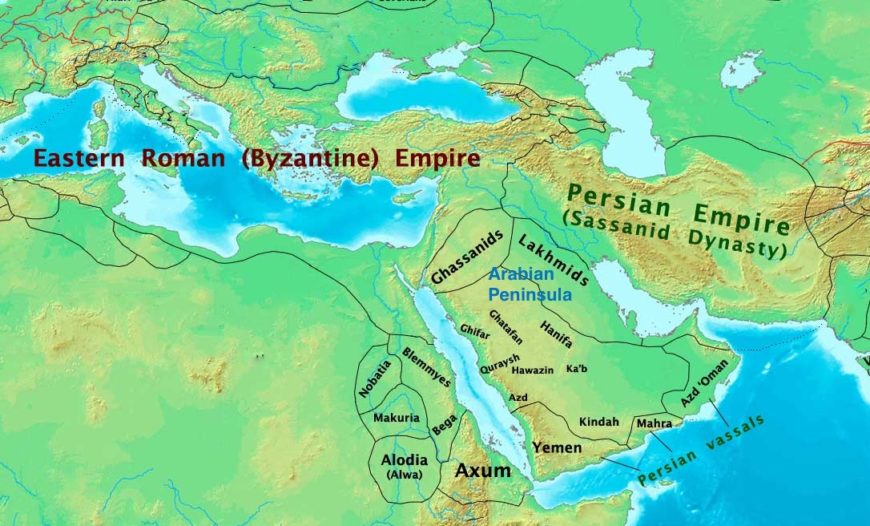Arabia is the last of inhabited lands towards the south, and it is the only country which produces frankincense, myrrh, cassia, cinnamon, and laudanum.Herodotus, The Histories, Book III
Centerpoint between empires
In the eyes of the ancient Romans, Arabia Felix—meaning “lucky Arabia”—was a rich and exotic place, at the limits of the Roman Empire. The incense and spices that grew in the south of the peninsula were certainly valuable commodities. But far from being at the edge of the world, late antique Arabia (encompassing the modern countries of Bahrain, southern Jordan, Kuwait, Oman, Qatar, Saudi Arabia, United Arab Emirates, and Yemen) was a centerpoint between the Byzantine and Sasanian Empires and the Kingdom of Aksum (spelled Axum in the map below), and this position helped to shape its history and culture.
Despite ancient Roman authors’ depiction of nomads wandering across the desert, most people in the Arabian Peninsula lived in settlements, whether small towns or monumental cities. The region was not unified as a single country; rather there were many different Arab tribes and kingdoms. This essay will survey some of the material culture of these groups from the beginning of the 1st century C.E. to Muhammad’s lifetime in the 6th century.

Mosaic depicting a camel-driver named Mouchasos, from Deir al-‘Adas, Syria, 8th century (photo: Michael Greenhalgh/Manar al-Athar)
Towns, oases, and trade-routes
The Arabian Peninsula has low rainfall and few rivers, so the locations of settlements were partly determined by access to water. The most densely settled areas were the Hijaz region in the west and Yemen in the south.
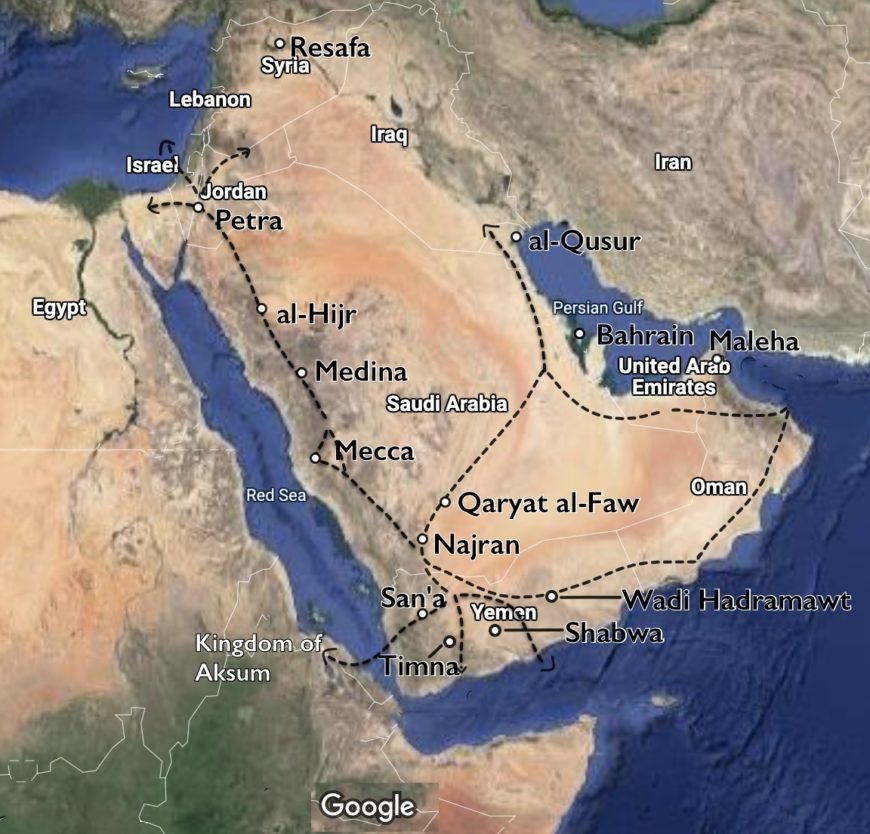
Sites mentioned in essay, with lines indicating main trade routes in Late Antiquity. (underlying map © Google)
Qaryat al-Faw: capital of the Kingdom of Kinda
An exception in central Arabia was Qaryat al-Faw, the capital of the Kingdom of Kinda. It was one of the few oases in the desert, and so a large proportion of overland travel passed through the city. Its inhabitants therefore had access to imported goods—some from as far away as Italy. The fragment of wall painting below is from the palace of Qaryat al-Faw, a fortified building in the middle of the city. It shows guests at a banquet reclining on couches and eating from individual bowls in the Greco-Roman manner, suggesting that this was a habit shared by the Kindite upper classes.
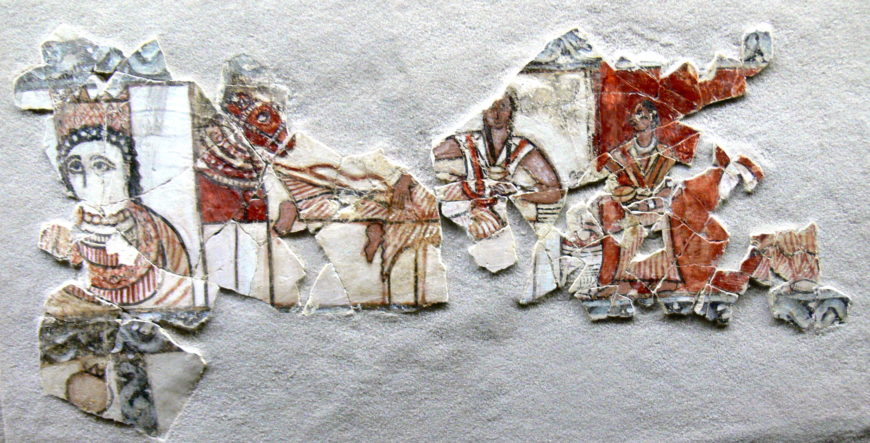
Painting from palace of Qaryat al-Faw, probably 1st or 2nd century C.E. (photo: Wolfgang Sauber, CC BY-SA 3.0)
The Kingdom of Himyar
Further south is the Hadramawt region, which in the 4th century C.E. became part of the Kingdom of Himyar.
Oasis cities such as Shabwa and Timna had existed here for centuries; again their position along the incense trade route made them wealthy, and the palace of Shabwa was decorated with imported alabaster, ivory, and bronze. The incense burner shown below comes from Timna’s pre-Himyarite era. Its cubic shape with rectangular indents resembles the architecture of temples, and it was probably also used in one.
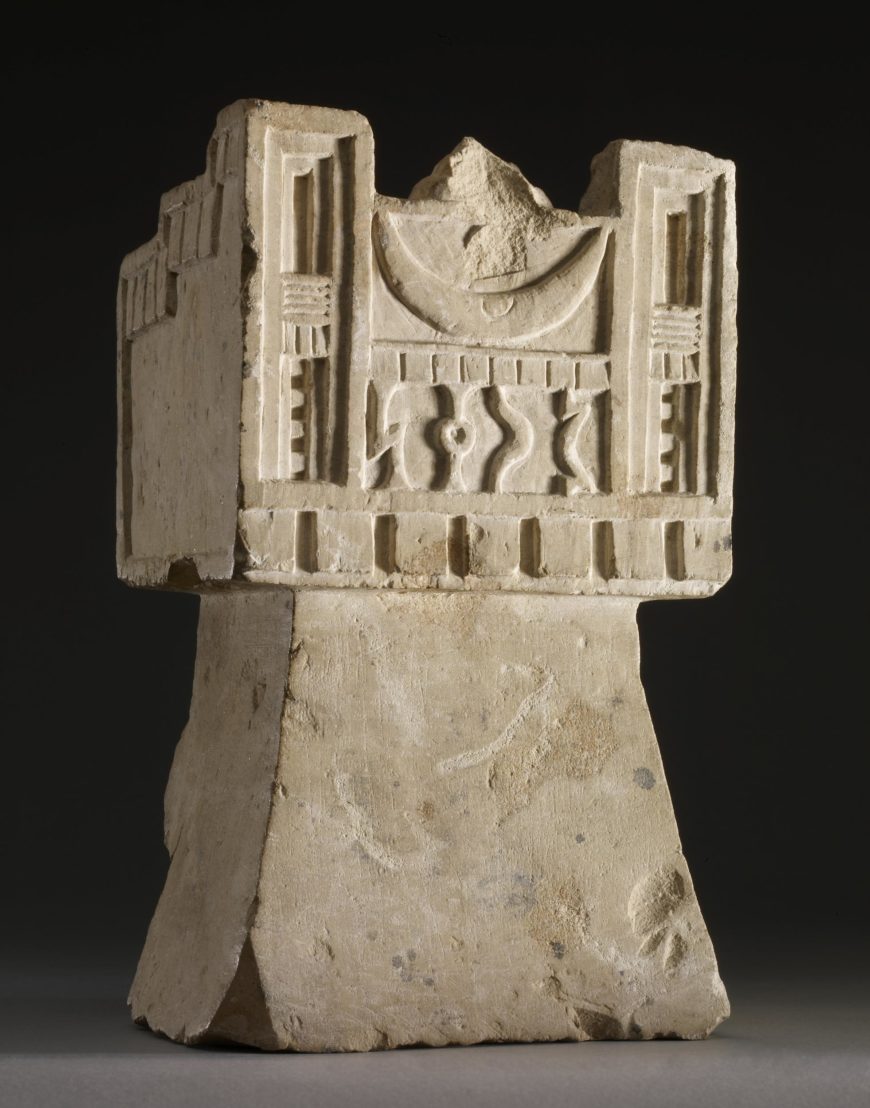
Limestone incense burner from Timna, Yemen, 1st century B.C.E. to 2nd century C.E. (The British Museum, CC BY-NC-SA 4.0)
The north-east coast
Coastal settlements flourished in the north-east of Arabia in the first three centuries C.E., trading across the Indian Ocean. Goods from the Levant, Iraq, Iran, and India have been excavated in houses and graves from Maleha. Funerary sculptures found on the island of Bahrain blend aspects of several cultures. The figures wear Parthian-style clothing, but some (like the man on the right below) have close-cropped hair in a more Roman fashion. Some fragments carry Greek inscriptions, and others Aramaic ones. While it is possible to distinguish the components in this way, the more important point is their combination—from the point of view of the 2nd- or 3rd-century Bahrainis, they are likely to have formed a coherent identity.

Funerary stele found near Qal’at al-Bahrain, 150–250 C.E., courtesy of the French Archaeological Mission in Bahrain and the Bahrain Authority for Culture and Antiquities, and with thanks to Pierre Lombard)
Nabatean Kingdom
The Nabatean Kingdom covered north-western Arabia and the southern Levant from the 3rd century B.C.E. to the early 2nd century C.E. The Nabataeans controlled trade in spices and incense from further south, and also produced distinctive ceramic vessels painted with flowers and leaves. Their capital was Petra, famous for its huge temples and tombs cut into the red sandstone cliffs. Another Nabataean city was al-Hijr or Madain Salih in Saudi Arabia, with similar rock-cut architecture.
Mecca
Mecca, the birthplace of Islam, was a smaller settlement than most of those mentioned, as it was not on major trade routes. It was already a pilgrimage destination however, as the square building known as the Kaaba was a shrine where a number of pre-Islamic gods were worshipped. Medina (Yathrib), where Muhammad gained most of his early supporters, was a larger oasis town.
Between empires
To the east of Arabia was the Parthian Empire, succeeded in the 3rd century C.E. by the Sasanians, while to the north and north-west was the Byzantine Empire (before that the Roman Empire), in addition to the Kingdom of Aksum directly to the west. Arabian kingdoms and tribes engaged with these neighboring powers as enemies, subjects, and allies—with impacts on the cultures of all sides. Sometimes, from an Arabian perspective, the impact was negative. Many of the impressive rock-cut tombs and temples of Petra were built in the century before the site was annexed by the Romans in 106 C.E., and its population and wealth declined after this as trade routes shifted. Similarly, coastal trading settlements like Bahrain and Maleha in north-east Arabia lost their main source of income and were abandoned in the 3rd century C.E. when the Sasanians gained greater control of the Persian Gulf.
There were also benefits to negotiating with Byzantine and Sasanian forces. In the 6th and early 7th centuries these two empires fought a series of wars. Some pre-Islamic Arabian groups fought on behalf of the larger powers—gaining financial and military support in return. The Ghassanid tribe allied themselves with the Byzantines, and the Lakhmids with the Sasanians.
![The al-Mundhir building, Resafa, Syria, mid-6th century. Photo: Christian Sahner/Manar al-Athar]](https://smarthistory.org/wp-content/uploads/2022/01/MAA80436_002_DSC_0256-870x519.jpg)
The al-Mundhir building, Resafa, Syria, mid-6th century (photo: Christian Sahner/Manar al-Athar)
These alliances could be expressed in architectural form. Close outside the city gates of Resafa in Syria is a hall (the al-Mundhir building) built for the Ghassanid leader al-Mundhir ibn al-Harith (562–83). On its walls a Greek inscription reads “The fortune of Alamoundaros triumphs!,” transliterating the ruler’s Arabic name into a hellenized (Greek) form. The main room is shaped like a cross, making it look like a Byzantine church, and it may in fact have been a church as well as an audience hall; it is simultaneously a Byzantine structure and an Arab one.
Abraha, a 6th-century Aksumite ruler in Yemen, was another ally of the Byzantines. The emperor in Constantinople (the capital of the Byzantine Empire) was said to have given Abraha gifts of expensive building materials like marble and glass mosaic to adorn his churches in San’a.
Gods and stones
A widespread religious practice in Arabia, going back into the first millennium B.C.E., was the veneration of selected stones. Shaped rocks called betyls are found at the Nabataean sites of Petra and Madain Salih, some carved with eyes and others featureless. The 9th-century Muslim author al-Kalbi described people seeking blessings from tall stones, although he aimed to emphasize the “ignorance” of paganism, so his reports may have been exaggerated. The Black Stone fixed to the east corner of the Kaaba in Mecca was also revered in the pre-Islamic period.
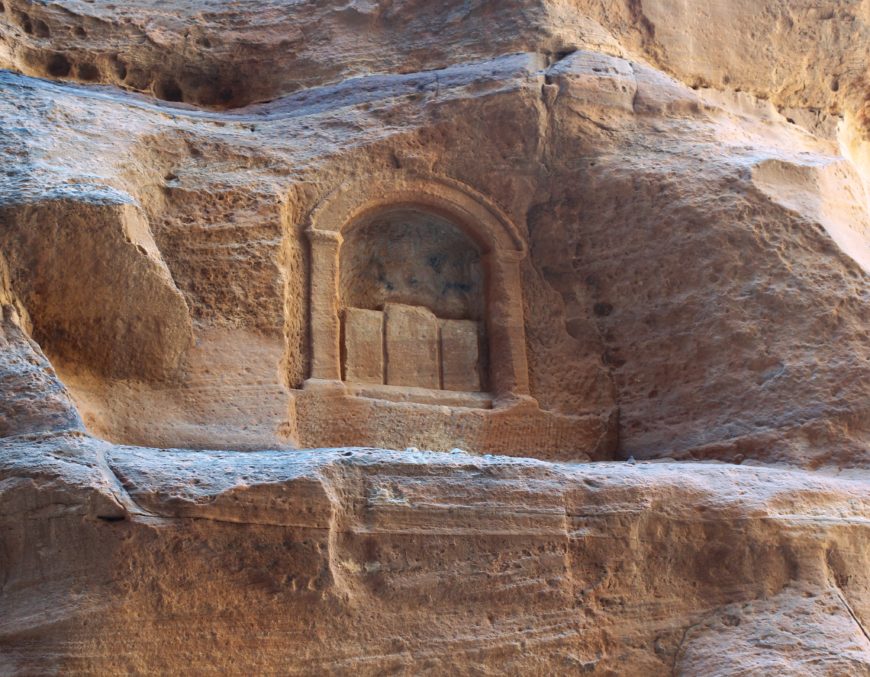
Betyls in a niche in the Siq canyon at Petra (photo: Otto Nieminen/Manar al-Athar)
Other common forms of devotion included animal sacrifice, and pilgrimages to sacred spaces; the Kaaba was one of these sanctuaries. Hubul, a god of rainfall and war, was probably venerated there, and Muhammad is said to have removed his statue from the shrine, along with paintings of other gods. The word Allah, “God” in Arabic, which is used by Muslims and Arabic-speaking Christians to mean the monotheistic deity, was the name of another pre-Islamic god, also worshipped in Mecca. The chief deities in the south were the sun goddess Shams, moon god Almaqah, and Attar, associated with Venus. Dhushara was worshipped by the Nabateans, and Ruda in other areas of northern Arabia, while Allat was worshipped throughout the peninsula.
In late antique Arabia, Judaism, Christianity, and to a lesser extent Zoroastrianism coexisted and competed with these pagan gods. In the immediate pre-Islamic period and until the 9th century, there were Christian communities along the coast of the Persian Gulf. The Himyarite rulers of Yemen were Jewish and their Aksumite rivals were Christian, and people of both religions lived there. Judaism was also popular in the western Hijaz region, particularly around Medina, providing some of the early converts to Islam.
Legacies
Some monuments of ancient and Late Antique Arabia were remembered well into the Islamic period. The richly decorated Christian churches of Yemen were described in glowing terms by 12th-century authors, long after the buildings themselves were disused. Some sites gathered new associations, for instance the stone tombs of al-Hijr were believed to be the homes of a tribe punished by God for disbelief. Others, most obviously the Kaaba, became essential elements of Islamic culture.
Other cultural forms again did not leave material traces, but were equally influential. There were sophisticated Arabian traditions of poetry and astronomy—sometimes combined to transmit astronomical knowledge in poetic form—which inspired later Islamic artists and scholars.
One feature of pre-Islamic Arabia was the combination of cultures, languages and artistic traditions. Early Islamic art is known for its mixture of styles and motifs of different origins, and in part this can be understood as a legacy of its Arabian origins.

